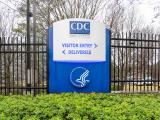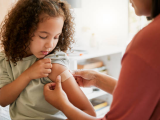Nov 4, 2009 (CIDRAP News) – The head of the Centers for Disease Control and Prevention (CDC) predicted today that the current wave of H1N1 influenza is likely to begin to wane before the shortage of vaccine for it eases.
Dr. Thomas Frieden made the comment at a wide-ranging US House subcommittee session that aired the reasons for and impact of the vaccine delays and the prospects for avoiding a repeat of the problem. The session was streamed over the Web.
"It's likely that the current wave of infection will peak, crest, and begin to decline before there are ample supplies," Frieden told the House Appropriations Subcommittee on Labor, Health and Human Services, Education, and Related Agencies. "Whether there'll be another wave of H1N1 between now and May and whether we'll get a different strain, only time will tell."
In a similar vein, an Alabama health official said there may not be enough vaccine doses to immunize people outside the priority groups until late December. He and other officials said the vaccine shortage has hurt the credibility of public health at all levels.
In other comments, federal health officials described the slow growth of the vaccine virus as the fundamental reason for the current vaccine shortage and suggested that vaccine production difficulties are likely to continue as long as the process relies on growing actual flu viruses, as opposed to producing specific viral proteins.
'Virus seems to be winning'
Rep. David Obey, D-Wis., chair of the subcommittee, voiced frustration over the vaccine shortage and said the same kinds of problems in flu vaccine production were discussed back in 2004 and 2005. In opening the session, he said the nation has made significant strides since the pandemic virus emerged, "but despite some successes, the virus seems to be winning."
In a brief update on the H1N1 situation, Frieden said the nation has now had "many, many millions of cases" of the illness, well over 20,000 hospitalizations, and more than 1,000 deaths, including 114 children.
He asserted that the illness "is no more severe than seasonal flu" but affects a different pattern of age-groups, as more than 90% of deaths are in people younger than 65—a sharp contrast to the seasonal virus.
As for the vaccine supply, Frieden said, "With 20-20 hindsight it's clear we should have been more skeptical" about projections of production timing.
Dr. Nicole Lurie, Department of Health and Human Services (HHS) assistant secretary for preparedness and response, said the cumulative vaccine production today reached 32.4 million doses. Despite repeated questions by the committee, she and Frieden firmly refused to make any new predictions about the flow of vaccine.
"To be quite honest, flu is really unpredictable, and we're very hesitant about projecting forward more than week to week, largely because anything could happen," said Lurie.
Shortage's impact on states and localities
Dr. Donald Williamson, Alabama's state health officer, said the vaccine shortage has forced Alabama to change its H1N1 vaccination strategy.
In September Alabama officials were told they could expect to get about 800,000 doses of vaccine by the end of October, but by Oct 23 the estimated amount was cut to about 400,000 doses, Williamson reported.
"Current projections show that 62% of the vaccine coming to Alabama won't be available until after December 1," he said. Further, it may not be possible to expand the vaccine to all Alabamans who want it until late December or January.
Because of the shortfall, the state decided to focus its vaccination efforts on the subpriority groups identified by the CDC and the providers most likely to serve them, rather than the broader priority groups. (The subpriority groups are pregnant women, healthcare workers, children 6 months through 4 years old, caregivers of babies under 6 months, and children between 5 and 18 with health conditions that put them at risk.)
In line with the strategy switch, school-based vaccination clinics have been postponed until late November or early December, Williamson said.
Rob Fulton, director of the St. Paul–Ramsey County Public Health Department in Minnesota, told the committee, "We know that the credibility of the entire public health system is in question because of the slow arrival of vaccine."
Like Williamson, he said the slow flow of doses is disrupting vaccination plans. For example, he said the county is anticipating getting 7,800 doses for school children age 9 and under, but the actual population in this age-group is 20,000. (Two doses of vaccine are recommended for children under age 10.)
Fulton also commented that 135 of his department's 320 employees are involved in the H1N1 response at least part-time, which means they have less time to spend on their regular work.
Williamson said the vaccine shortage not only undermines public health's credibility, but also leads people to question the vaccine's safety. He also voiced concern about the public's willingness to get the immunization later in the season when supplies finally improve.
Root of the problem
In discussion about the cause of the vaccine delays, Dr. Anthony Fauci, director of the National Institute of Allergy and Infectious Diseases (NIAID), said the basic problem was the slow growth of the vaccine virus in eggs, in combination with the timing of the epidemic.
The virus emerged in April, about 3 months later than planning for seasonal flu vaccine normally begins, he said. Then the virus never went away in the summer and was waiting when children went back to school, sparking an epidemic much earlier in the fall than usual, he added.
"You have flu waiting for you when the kids go back to school and you have a slow grower, that's the answer," Fauci said.
Obey asked if the need to provide some vaccine free of thimerosal, a mercury-containing preservative, contributed to the vaccine delays. Thimerosal-free vaccine is produced in individual syringes; putting vaccine in multidose vials is faster but requires thimerosal.
Fauci said production of thimerosal-free vaccine probably contributed "a bit" to delays, but was not the major issue. "The fundamental basic problem is the virus not growing well," he said.
Lurie said one of the steps HHS has taken to speed production was to ask the manufacturers to shift production to multidose vials as much as possible.
She acknowledged that HHS so far has ordered the filling and finishing of only 117 million of the total 250 million doses of bulk vaccine it has contracted for. "This week we've issued orders for more vaccine [to be filled and finished] so we don't have a gap," she said. "That 117 million has taken us further into the year than we thought it would."
Lurie said the agency is using a staged approach to filling and finishing because it doesn't want to have a lot of leftover finished vaccine. "It's better to keep it in bulk form so it could be used in the seasonal campaign next year or could be used potentially in the developing world."
Fauci asserted that the vaccine makers are not to blame for the vaccine delays. "I don't want anyone to get the impression that it's the drug companies' fault this has happened," he said. "It's just the nature of the biology of the virus that it created an expectation that there'd be a certain amount."
The 'end game' for vaccine technology
Federal officials were questioned about the use of cell-based methods to make flu vaccines, as is now done to some extent in Europe. Cell-based production is considered more flexible and reliable and somewhat faster than the 1950s method of growing the vaccine virus in chicken eggs.
Lurie noted that a cell-based vaccine plant is being built by Novartis in North Carolina and is expected to be ready to start making vaccine in 2011. But how soon a cell-based flu vaccine will win Food and Drug Administration approval is uncertain, she added.
The Novartis plant "will get us a little shy of halfway to what our pandemic goal will be," to make enough vaccine for the entire population, she said.
Fauci said cell-based technology will be an improvement but is not the final answer to flu vaccine production problems. "We want to take vaccinology into the 21st century by not requiring the virus to grow. . . . The end game is to get away from requiring the virus to grow."
He said a number of newer approaches involve making particular viral proteins instead of growing the whole virus. One example is using baculovirus, an insect virus, to make the gene for hemagglutinin. He said one company is conducting phase 3 trials of a vaccine using that technique.
"What we're going to see over the next years is a gradual transition from egg-based [vaccine] to egg-based with cell-based to advanced molecular technology," Fauci predicted.
But the ultimate goal, he said, is to make a universal flu vaccine—one that targets a component of the flu virus that doesn't change from season to season. Such a vaccine could be made and stored in large quantities, and people wouldn't have to be vaccinated every year.
"That's the plan. That's going to take years," he said.


















